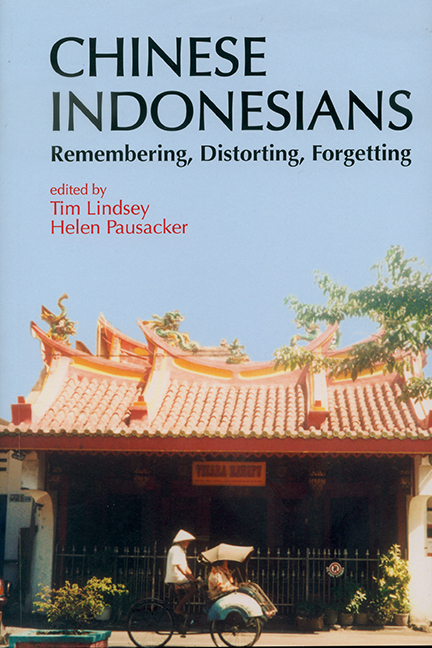Book contents
- Frontmatter
- Contents
- Preface
- A Brief Biography
- Contributors
- Glossary
- Introduction: Researching the Margins
- Bibliography of Charles Coppel's Work
- 1 Anti-Chinese Violence and Transitions in Indonesia: June 1998–October 1999
- 2 Reconstituting the Ethnic Chinese in Post-Soeharto Indonesia: Law, Racial Discrimination, and Reform
- 3 Buddhism and Confucianism in Contemporary Indonesia: Recent Developments
- 4 Portrait of the Chinese in Post-Soeharto Indonesia
- 5 The Makam Juang Mandor Monument: Remembering and Distorting the History of the Chinese of West Kalimantan
- 6 Confucianists and Revolutionaries in Surabaya (c1880–c1906)
- 7 The Chinese and the Early Centuries of Conversion to Islam in Indonesia
- 8 The Agony of Love: A Study of Peranakan Chinese Courtship and Marriage
- 9 Peranakan Chinese and Wayang in Java
- Index
3 - Buddhism and Confucianism in Contemporary Indonesia: Recent Developments
Published online by Cambridge University Press: 21 October 2015
- Frontmatter
- Contents
- Preface
- A Brief Biography
- Contributors
- Glossary
- Introduction: Researching the Margins
- Bibliography of Charles Coppel's Work
- 1 Anti-Chinese Violence and Transitions in Indonesia: June 1998–October 1999
- 2 Reconstituting the Ethnic Chinese in Post-Soeharto Indonesia: Law, Racial Discrimination, and Reform
- 3 Buddhism and Confucianism in Contemporary Indonesia: Recent Developments
- 4 Portrait of the Chinese in Post-Soeharto Indonesia
- 5 The Makam Juang Mandor Monument: Remembering and Distorting the History of the Chinese of West Kalimantan
- 6 Confucianists and Revolutionaries in Surabaya (c1880–c1906)
- 7 The Chinese and the Early Centuries of Conversion to Islam in Indonesia
- 8 The Agony of Love: A Study of Peranakan Chinese Courtship and Marriage
- 9 Peranakan Chinese and Wayang in Java
- Index
Summary
INTRODUCTION
Throughout his academic career, Charles Coppel wrote extensively on Confucianism in Indonesia, covering the period from the beginning of the twentieth century until 1995 (Coppel b2002a–e). Both of us were the first academics who paid special attention to this unique religion developed in Nusantara (Suryadinata 1974; Coppel 2002b). Charles focused more on the historical aspect of Confucianism (Coppel 2002c–e), while I myself wrote more on contemporary issues (Suryadinata 1974; 1997, pp. 125–94; 2002a,b). This chapter addresses the developments of Confucianism after the fall of Soeharto and analyses how government policy has influenced the interaction of Confucianism and Buddhism.
At the beginning of the New Order (1966–98), Soeharto began to introduce an assimilation policy towards the ethnic Chinese in Indonesia. This was new because during the Liberal Democracy Period (1949–58) and the Guided Democracy Period (1959–65), government policy had shifted from liberalism to integration. The three Chinese cultural pillars, namely Chinese media, Chinese organizations, and Chinese-medium schools, were allowed to operate. From 1958 Indonesian citizens of Chinese descent had been required to attend Indonesian-medium schools, many of which were sponsored by the Chinese community. Indonesian Chinese who were foreign citizens, however, were permitted to continue their education in Chinese-medium schools.
SOEHARTO'S ASSIMILATION POLICY TOWARDS ETHNIC CHINESE
With Soeharto's rise in the wake of the abortive coup of 1965, however, the policy towards the ethnic Chinese changed fundamentally. Soeharto's New Order was suspicious of the Chinese community's links with the People's Republic of China. Eager to establish a “homogeneous nation”, the government decided to introduce an assimilation policy towards the ethnic Chinese. It is imperative to note that the so-called “homogeneous Indonesian nation” was based on the indigenous model. The ethnic Chinese were “non-indigenous” and therefore had to abandon their cultural identity if they wanted to become “genuine Indonesians”. The indigenous Indonesian identity, to which they were to transform was, however, vaguely defined. As it turned out later, the indigenous Indonesian identity was nothing but an identity which was “non-Chinese”.
- Type
- Chapter
- Information
- Chinese IndonesiansRemembering, Distorting, Forgetting, pp. 77 - 94Publisher: ISEAS–Yusof Ishak InstitutePrint publication year: 2005



